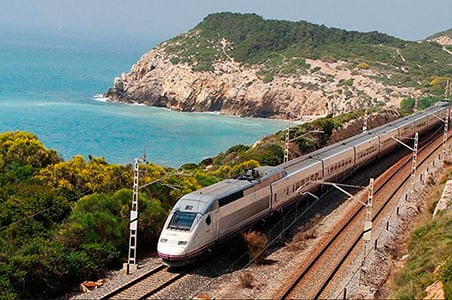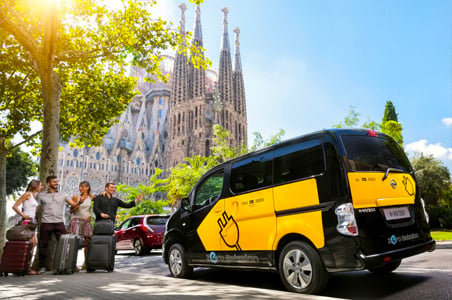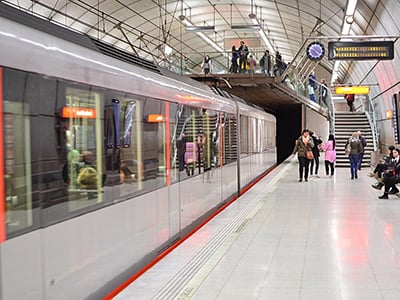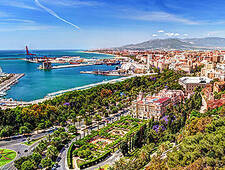Spain offers extensive transportation options via road, railway, sea, and airways. Its advanced network of public transport in Spain allows travelers, locals, and expats to reach any destination easily.
 There might be regional differences, so having in-depth knowledge of these transportation facilities is essential for newcomers.
There might be regional differences, so having in-depth knowledge of these transportation facilities is essential for newcomers.
Especially after Spain’s major turnover as a leading tourism center in Europe, Spanish Government has focused on improving accessibility to every corner of the country.
Along with its increasing reputation among holidaymakers, the private sector also took advantage of this opportunity. With new initiatives, they brought Southern Spain’s airports to the forefront of airline companies' most frequent destinations. The intensely competitive environment has kept prices reasonable.
It is possible to divide the network of the best transportation in Spain into three specific categories: Intercountry, Intercity, and in-city. Here are some of the best tips to keep in mind about transportation in Spain.
Intercountry Transportation: How to Travel to Spain from Abroad
Despite that it’s the most common way of traveling to Spain, the airway isn’t the only option when changing countries. You can reach Spain’s most renowned ports via cruises, and cross the Spain-France border by train or intercountry busses.
Spain’s most attractive vacation spots are focused around its long stretch of coastline, extending from the French border on the north to Gibraltar on the south. A great part of travelers also chooses to take a cruise trip, especially from other European countries and the USA. The busiest ports of Spain that host international cruise ships are Barcelona, Mallorca, Málaga, Cadiz, and Valencia.
If you are not an adventurous person, airways will be the most suitable option to save time. There are 36 airports in Spain open to international flights. The most important ones among these are Madrid Barajas, Barcelona International, Valencia, Málaga, Alicante, Palma de Mallorca, Seville, and Zaragoza Airports.
The largest and busiest airport in Spain and the second largest one in Europe is the Aldofo Suárez Madrid-Barajas Airport. Madrid’s international airport is followed by the Barcelona El Prat Airport as the second busiest.
Málaga’s Coste del Sol Airport or Alicante Airport are the best tourist arrival destinations. They are the gateway that opens to the ultimate Spanish vacation on the best southern promenades of the country. Málaga Costa del Sol Airport welcomed 18 million passengers in 2022. The same year, Alicante Elche Airport came after Málaga with 13 million passengers.
How to Get Around in Spain: Intercity and In-City Transportation
You can also travel between Spanish cities or in the city by bus, taxi, your own car, train, or subway. Each of them has its own unique features and rules.
Buses
Buses are the most widely used vehicles in Spain. In general, bus transportation in Spain’s cities is quite comfortable and also affordable.
Not only while traveling between cities, but buses also play a big role in daily life. The tariff is almost one-sixth of taxis. The cost of single-use tickets can vary from one city to another since public transportation in Spain by bus is operated locally. Nowadays, it is possible to find timetables and bus routes online.
If you don’t speak Spanish, learning the pronunciations of the places you plan to go might help you to communicate with drivers. In the summertime, try to find out the sunny part of the bus and avoid it. And keep in mind that in the summer season, the buses can mostly be full.
As a common behavior, people get into the bus from the front door and out from the middle. You can buy tickets on the bus but there might be exceptions. In this case, you should find the stations where they sell the tickets.
Taxis
 Taxis are widely used throughout Spain, but there are certain things to keep in mind about them. Even though the colors may change from one city to another, you can easily distinguish a taxi with its green light to indicate that it is available.
Taxis are widely used throughout Spain, but there are certain things to keep in mind about them. Even though the colors may change from one city to another, you can easily distinguish a taxi with its green light to indicate that it is available.
When you get into a taxi, you can check if it is a real one by looking at the panel which should show the identity of the driver. And also, check if the taximeter is working properly so that you won’t have to deal with awkward issues about pricing.
The cost of transportation in Spain via taxis is not much different than in other European countries but slightly might change by city and the taxi company. By taking into account the emergencies, keep the contact number of the taxi with you.
Payments are generally made in cash, but some taxi transport companies in Spain also accept credit cards. So it would be beneficial to highlight the payment method beforehand to avoid confusion.
Train
The railway network of Spain is considered the best way of cheap transportation in Spain. It is one of the cheapest ones in Europe, although it is slightly behind European standards in terms of punctuality.
The network of high speed trains in Spain is operated by Renfe, one of the biggest transportation companies in Spain. Therefore, Renfe (Spanish Railways) has initiated a comprehensive modernization program in the last decade to reduce travel time by 50%. Within this program, the AVE (the high-speed train) system has been activated.
The AVE stands for Alta Velocidad Española. If you are planning to travel by train in Spain, it has the best services. The high-speed Spanish trains can operate at 311 km/h. It is always being expanded nationwide, and also to France.
Currently, the AVE network is extending towards not only the southeastern coasts of the country but also to the France borders. Renfe cooperates with the national railway company of France, SNCF. A trip from Paris to Barcelona takes about 6.5 hours with AVE, while by car it takes between 11-14 hours car ride.
The main routes within the country connect Madrid with Zaragoza, Barcelona, Valencia, Alicante, Cordoba, Sevilla, and Málaga. You can find the timeline and railway map on the official website of Renfe.
AVE reduced the time spent on the way by a lot. For example, a journey from Madrid to Málaga takes 2,5 hours while by car it’s around 6 hours. When compared to airways, combined with the time spent in the airport, it’s still advantageous to travel with AVE within the country.
Usually, train tickets are open for booking around 90 - 60 days before the departure date and can be found on Renfe’s website.
Renting a Car and Driving in Spain
If you are planning to travel to small Spanish towns, the countryside or to discover different beaches it would be better to have a car of your own. You should be above 18 to have a driving license in Spain. To rent a car, you should be above the age of 21.
Keep in mind that you will need a credit card to pay the deposit while renting a car. If you are going to rent a luxury car, then you may need two different cards.
If you are a citizen of a non-EU country, you will need International Driver’s Permit (IDP). While driving in Spain, your IDP must be with you at all times, along with your original driver’s license. If your driver’s license is EU-compatible, you won’t need to obtain IDP.
In general, driving rules in Spain are similar to other countries. Traffic runs from the right. You will be surprised by the number of roundabouts in Spain. Keep in mind that you always have to give way to your left-hand side in roundabouts.
It would be better if you pay attention to the road types since some might require payment if used. The most commonly used ones are Autovías (A) and Autopistas (AP). You can check out our blog about driving in Spain for further information.
Metro
 Madrid, Barcelona, Valencia, Palma de Mallorca, and Bilbao have their own metro systems. Other cities in Spain such as Alicante or Málaga use metro-like advanced tram systems instead.
Madrid, Barcelona, Valencia, Palma de Mallorca, and Bilbao have their own metro systems. Other cities in Spain such as Alicante or Málaga use metro-like advanced tram systems instead.
Ticket prices vary, as each metro and tram network is run by a local transportation authority. Cities with larger networks, such as Madrid or Barcelona, may have additional costs based on distance or the number of zones you travel.
The Metro in Madrid is the largest, with 13 metro lines plus one branch. This is the oldest metro system in the whole country, covering 300 metro stations. Madrid’s metro is used by approximately 3 million people every day. Metro de Madrid operates between 6 a.m. and 1.30 a.m. on the next day.
Barcelona has one of the most modern metro systems in Spain. There are 12 lines, not running short from the capital Madrid.
The metro network in Valencia started its operations in 1988 and developed itself in time. The metro of Valencia has 9 lines, with four single zones A, B, C, and D. Ticket prices are determined by how many zones you will be traveling across. Trains run from 5 a.m. till midnight.
Spain metro maps can be found on the official website of the operators. These websites also include schedules, routes, and transfer points.
Traveling in Spain by road, railways, airways or sea routes is easy and comfortable, the same as living your best life under the sun. Explore the essentials of life in Spain by reading our articles on our blog page.




